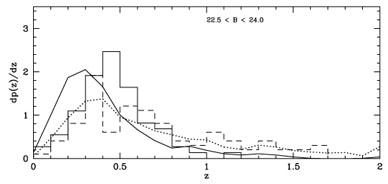


Following
Frenk et al. (1997)
some basic facts such as the abundance of
DM halos, their merging history and their internal structure are
reasonably well understood. Semi-analytical models satisfactorily
explain the luminosity function, the number counts and colours, the
evolution of the Hubble sequence, the morphological type, the history
of star formation, etc. However, no model has succeeded in
producing a faint end slope of the galaxy luminosity function flatter
than
![]()
![]() 1.5, whilst the observations indicate
1.5, whilst the observations indicate
![]()
![]() 1.
1.
Reasonable results are also obtained for the morphologies of galaxies. Galaxies with disks and bulges are directly obtained. They may merge producing an elliptical galaxy. There is increasing evidence that ellipticals arise from the mergings of spirals. Apart from the theoretical models, Pfenninger (1997) vigorously argues in favour of the evolution from the so called "late" to the so called "early" galactic types. There is general agreement on this, though an elliptical may then develop a new disk. However, the gaseous disks obtained are too small, due to the loss of angular momentum to the halo when they form. Note that in the early interesting models by Larson (1974) where no dark matter was considered, just gas and stars, and the calculations were not obtained from a cosmological scenario, no combination of free parameters was able to produce large enough disks. After many years the formation of disks is still a poorly known process.
One of the most remarkable successes is the ability of semi-analytical models to match the counts of faint galaxies as a function of magnitude, redshift and morphology, particularly when standard CDM cosmology is adopted. Frenk et al. (1997) wrote "This agreement is the most striking indication so far that the models contain some element of truth". The redshift distribution of galaxies with magnitudes in the range 22.5 < B < 24.0 is reproduced in Fig. 16. This agreement was only obtained when the data from Cowie et al. (1996) and the Miller-Scalo IMF become available.

|
Figure 16. The redshift distribution of galaxies with magnitudes in the range 22.5 < B < 24.0. The solid histogram shows the data of Glazebrook et al. (1995), while the dash histogram shows the (more complete) data of Cowie et al. (1996). The lines show the predictions of the model of Cole et al. (1994) for a Scalo IMF (solid line) and a Miller-Scalo IMF (dotted line). From Frenk et al. (1997). Courtesy of the Astronomical Society of the Pacific. |
The Lyman Break galaxies
(Steidel et al. 1996)
probably constitute the
first generation of star forming galaxies. They are therefore a
challenge for theoretical models, especially considering that their
adjustable parameters are set taking into account z=0
properties. Lyman Break galaxies have little emission in the U filter,
because the redshifted Lyman Break with rest-wavelength at 912Ålies
redwards from the wavelength range of the U filter,
while redder filters are still unaffected and transmit a higher
signal. This is what should be expected for galaxies with z![]() 3 and
what Keck has spectroscopically confirmed. This discovery was
disconcerting for hierarchical CDM models as they had predicted that galaxy
formation was a very recent phenomenon (with z
3 and
what Keck has spectroscopically confirmed. This discovery was
disconcerting for hierarchical CDM models as they had predicted that galaxy
formation was a very recent phenomenon (with z![]() 1). It seems,
however, that the use of the Miller-Scalo IMF instead of the earlier
Scalo IMF again provides an agreement with the observations of the Lyman
Break galaxies. Furthermore, a readjustment of the
1). It seems,
however, that the use of the Miller-Scalo IMF instead of the earlier
Scalo IMF again provides an agreement with the observations of the Lyman
Break galaxies. Furthermore, a readjustment of the ![]() parameter is
required. Agreement is obtained for both the standard CDM and the
parameter is
required. Agreement is obtained for both the standard CDM and the
![]() CDM models, both of which predict a similar early star
formation
history. Some of the present galaxies could have had a Lyman Break
progenitor, specially the brightest galaxies. A bright spiral galaxy
could be the descendant of a single fairly massive Lyman Break object;
a bright elliptical could be the descendant of two less massive
ones, merging at more recent epochs
(Baugh et al., 1998;
Frenk et al. 1997;
Gobernato et al. 1998).
As studied by
Baugh et al. (1999),
a remarkable success of the theory is that models can be
adjusted so that the agreement with the z=0 galaxy clustering
(Postman et al 1998
and others) also agrees with the clustering data at z=3 given by
Alderberger et al. (1998).
Figure 17 plots the
theoretically obtained present B luminosity.
CDM models, both of which predict a similar early star
formation
history. Some of the present galaxies could have had a Lyman Break
progenitor, specially the brightest galaxies. A bright spiral galaxy
could be the descendant of a single fairly massive Lyman Break object;
a bright elliptical could be the descendant of two less massive
ones, merging at more recent epochs
(Baugh et al., 1998;
Frenk et al. 1997;
Gobernato et al. 1998).
As studied by
Baugh et al. (1999),
a remarkable success of the theory is that models can be
adjusted so that the agreement with the z=0 galaxy clustering
(Postman et al 1998
and others) also agrees with the clustering data at z=3 given by
Alderberger et al. (1998).
Figure 17 plots the
theoretically obtained present B luminosity.

|
Figure 17. Present-day B-band luminosity
functions in a model
with [ |
Salvador Solé et al. (1998) took into account that continuous accretion between mergers and tiny mass captures have a very different effect from notable mergers. Between abrupt major mergers, the central parts of halos grow steadily and their virial radius continues to expand.